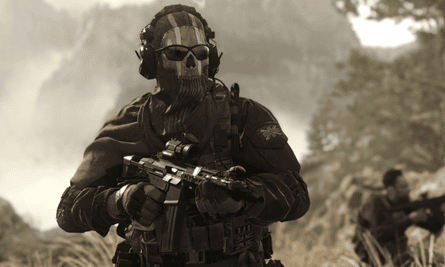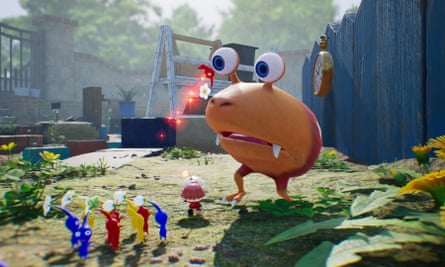It’s been an absolute gossip bonanza in the past couple of weeks for those of us who follow the games industry. The hearing on Microsoft’s proposed acquisition of Activision Blizzard by the US Federal Trade Commission (FTC) has exposed reams of previously confidential data about how Xbox and PlayStation do business, and some of the juiciest info was released accidentally. Some poor clerk with a black marker did a poor job redacting some of the documents involved in the case, meaning that they were easily legible from the court’s official scans. The documents were quickly removed from public view, but not before journalists had had a field day with them.
This is how we now know exactly how much Sony is spending on its showpiece PlayStation 5 games (previously we only had an estimate from ex-PlayStation boss Shawn Layden, which turned out to be roughly accurate). Horizon Forbidden West (pictured below) cost a reported $212m over 5 years, with a team of 300; The Last of Us Part II came in at $220m and took even longer. And those figures don’t even include marketing costs.
This is in line with major Hollywood movie budgets, and provides a stark insight into how expensive it actually is to create cutting-edge games these days; nobody outside four or five big studios could even entertain spending that kind of money.
It is wild how little we know about the inner workings of the games industry’s biggest players, so to speak. Game budgets are almost never disclosed; technical game development secrets are jealously guarded. Microsoft stopped even releasing sales figures during the Xbox One era. It has been easy to see, from the outside, that the money involved in game development has been ballooning out of control – developers are happy to talk about it – but now that we’re looking at the exact figures, we can see exactly how much.
For Sony, spending such enormous sums on games makes sense, because these games are advertisements for the PlayStation itself. You can only play God of War or Horizon on a PlayStation 5, and Sony has spent the past 15 years investing in the best stable of developers out there. And despite the outlay, it’s profitable. The PlayStation 5’s biggest exclusive games have sold eight to 10m copies, and let’s not forget that, unlike Ubisoft or Activision or any other publisher that makes games for PlayStation, who pay a 30%-ish cut to sell games through the PlayStation Store, Sony gets to keep all the profits.
Indeed, without exclusivity – without platform holders like Sony willing to invest in high-end game development to give themselves a competitive advantage, and willing to partner with game development studios on marketing – it’s doubtful that games of this scale would get made very frequently, if at all. Instead, studios would focus more on service games with long-term revenue possibilities: the Fortnites and Robloxes of the world, ever keen to squeeze players for an extra few quid and an extra few hours. This is the benefit that we, as players, get from platform exclusivity: games that are exceptionally high quality, because they are vectors to sell consoles.
Perhaps unsurprisingly, as Microsoft has only recently busted out the chequebook and bought itself a stable of studios to make exclusive games for the Xbox, Microsoft’s boss Satya Nadella doesn’t like the whole concept of exclusive games. Giving evidence at the FTC hearing last Wednesday, he said: “If it was up to me, I would love to get rid of the entire [idea of] exclusives on consoles, but that’s not for me to define, especially as a low-share player in the console market … I have no love for that world.”
This “low-share” player is currently trying to spend almost $70bn on Activision Blizzard and King, and thereby buy it a dominant position both on consoles and mobile. A 2019 email from Xbox head of game studios Matt Booty, in which he wrote that “we [Microsoft] are in a very unique position to be able to go spend Sony out of business” – was defended in court as representative of an outdated strategy that Xbox never actually pursued. Documents also revealed that Microsoft was considering buying up Sega, Square Enix, Bungie, Niantic and Supermassive, among others – as well as the many game studios and publishers that it has actually bought over the past five years, including Double Fine, Bethesda and Obsidian.

The company’s determination to outspend the competition has been evident for a while. It sits in contrast with Xbox boss Phil Spencer’s declarations that it wishes to act in the interests of gaming as a whole and play nice with its competitors. Microsoft is keen to portray itself as the underdog, even opening this FTC testimony with a statement about how it has lost the console wars, consistently coming in behind Sony and Nintendo since it first launched the Xbox in 2001. It is a little hard to swallow such self-deprecation from the third-biggest tech company in the world.
More surprising was PlayStation boss Jim Ryan’s private response to the news that Microsoft planned to buy Activision Blizzard – in which he says that Call of Duty (pictured above) would probably not be removed from PlayStation platforms as a result of the deal, saying: “We’ll be OK – more than OK.” This is a rather different line to the one spun for UK regulators: Sony was trying to convince them that Microsoft owning Call of Duty would be disastrous for the PlayStation business. That said, details about the popular shooter’s revenue on PlayStation do make you wonder: COD accounts for $1bn in PlayStation sales, according to those poorly redacted documents; 13% of PlayStation owners spend at least 30% of their gaming time on COD; and there are about a million PlayStation owners who play literally nothing else.
There are plenty of other interesting details from the past couple of weeks of testimony, including a very revealing claim from Spencer that Microsoft bought Bethesda’s parent company, ZeniMax Media, in a $7.5bn deal, to prevent Sony from paying it off to make Starfield exclusive to PlayStation. It all reminds me a little of the US rivalry between Sega and Nintendo that ended up changing the course of the games industry in the 1990s, as detailed in the book Console Wars, which was made into a documentary in 2020. Of course, we all know what happened there: Sega might have survived that war, but it is a shadow of its former self.
This trial is revealing some of the games industry’s best-kept secrets: how much things cost, what the architects of the industry are saying in private, and how two of its biggest rivals are working to get an edge over each other. It’s also revealing the lengths that Microsoft is willing to go to in order to buy an advantage in games, after spending the last 20 years in third place.
It’ll make a good documentary, in another decade or two.
What to play

I have been drawn back into the cute yet mildly disturbing garden world-in-miniature of Pikmin again this week, as a demo of the upcoming Pikmin 4 hit the Nintendo Switch alongside rereleases of the GameCube classics, Pikmin 1 and 2. (Don’t expect a massive upgrade on these – they’re mostly the same as they were in the 00s, fonts and all.)
Inspired by Shigeru Miyamoto’s fondness for gardening, these strategy games have you, a little spaceman, ordering around a small crowd of sentient plant-people and trying to prevent them from drowning, getting lost, or getting eaten by nasty creatures. It gives both parental anxiety and strategic satisfaction. Watching a whole new generation traumatise themselves by losing an entire squad to the Man-at-Legs on Twitter, Twitch and TikTok has been hilarious, too.
Available on: Nintendo Switch
Estimated playtime: 3 hours (plus 10 hours each for Pikmin 1 and 2)
after newsletter promotion
What to read

-
After Lord of the Rings: Gollum (pictured above) was met with a disastrous reception – it has a Metacritic average of 39 – German game studio Daedalic has decided to shut down internal development and focus on publishing instead. Oof. The stakes are higher than ever in game development now.
-
A great article in the New Yorker (£) here about museums’ struggles and successes exhibiting video games, now that they’ve finally come around to the fact that they are culturally valuable works: “The problem isn’t so much that video games lack institutions as that they have been severed from the broader study of culture. The form has shaped how millions see the world. There ought to be exhibitions on Myst and Surrealism; The Sims and interior design; Red Dead Redemption, Albert Bierstadt, and the American West.”
-
Amid riots that have engulfed France in the wake of a police shooting of an unarmed 17-year-old, Emmanuel Macron has taken a familiar old line and declared that video games are, in fact, the problem. “They are acting out the violent video games that have poisoned their minds,” the French president said of the (mostly young) rioters, echoing a line favoured by Trump and the NRA. (Once again, no link has ever been established between video games and real-world violence, despite plentiful studies into the issue.)
-
There have been so many game announcements in the past month that they’ve all blurred into one, but Annapurna’s new Blade Runner game still caught my attention. Set in 2033 – so between the two films – it’s called Labyrinth and is being directed by Chelsea Hash, who also led development on Solar Ash and Radiohead’s Kid A Mnesia Exhibition.
What to click
I tried to explain the ZX Spectrum to my son. It didn’t go well | Dominik Diamond
The video game that made me feel seen as a trans person | Ceridwen Millington
Queer representation in video games has never been better – let’s not stop now | Aimee Hart
Story of Seasons: A Wonderful Life review – soothing and sentimental farming sim
Question Block

Today’s question comes from reader Marie:
“What is your favourite console controller through the years? After (way) more than a decade, I have recently picked up a N64 controller again and they were so awkward to hold now! But I can appreciate the funky design.”
The N64 controller is way underappreciated, if you ask me. If you can figure out how to hold it without someone having to show you, what even is the point? Today’s kids don’t know they’re born, with their dual sticks and haptic triggers.
The serious answer to this question is undoubtedly the PlayStation 5’s DualSense controller. Not only does it look beautiful, with its glowing strip of light and its hidden details (zoom in far enough on a photo of the controller and you’ll see that it’s patterned with the PlayStation symbols to give it that grippable texture), but the resistance triggers and sound that it emits actually change the way you experience games. Feeling sword blows land on my shield with a juddering clang in Demon’s Souls made me appreciate the game all the more.
In my heart, though, my favourite game controller is the GameCube’s. It’s so small! It’s so purple! And there’s still nothing better for playing Smash Bros.
If you’ve got a question for Question Block – or anything else to say about the newsletter – hit reply or email us on [email protected]

